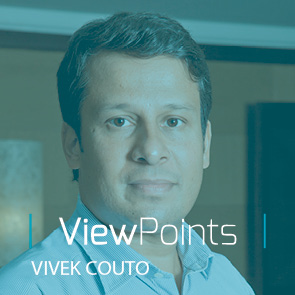
Vivek Couto is the Executive Director and Co-Founder of Media Partners Asia (MPA), the leading independent provider of research, advisory and consulting services across media, and telecoms industries in Asia Pacific. At MPA, Vivek leads teams to offer clients advisory services, market research, asset appraisal and M&A-related due diligence. He has 25 years experience across the media & telecommunications industries. Vivek is a graduate from the London School of Economics & Political Science with a BSc Economics degree and an MSc Economics degree in International Political Economy and also a member on the Board of the Infocomm Media Development Authority of Singapore (IMDA).
Vivek talked to us about the massive growth of streaming video and its impact on media in the Asia Pacific region.
What led you to co-found MPA?
Media Partners Asia was founded in 2001 with the purpose to serve a community of need and interest focused on the analysis of the media and telecommunications industries in Asia Pacific. We aimed to look at how media was developing in one of the fastest growing regions in the world, how people were investing in infrastructure, how companies were growing brands to serve a wide range of consumers in markets like China, India, Australia, New Zealand, Southeast Asia, Japan, Korea, Taiwan and so forth.
What are the big stories/trends in the media industry in APAC right now?
Asia Pacific has always been on the forefront of technology, mobile infrastructure and innovation. We have seen a lot of change. I think the two biggest trends at the moment are:
- the shift from the household user to the individual user, largely driven by the growth of mobile and largely through the first spurt of 3G then 4G and now 5G, which is being deployed at scale in Korea, Japan and other parts of Asia.
- massive changes in broadband democratization by companies like Reliance in low ARPU emerging markets like India. The infrastructure has been laid, and as a result of that, it’s enabled the growth of what we call the digital economy, which obviously RealityMine is at a forefront of in terms of the work you do globally.
These trends have certainly driven our focus as a business since 2015/16 in terms of how we are measuring consumption and revenue generation across media and telecoms.
We’re obviously seeing massive growth in SVOD and AVOD ‘Over The Top’ streaming services, with people watching on different devices, phones and tablets. What do you think this dramatic change means for the media measurement industry in the APAC region?
It creates new opportunity, but also creates confusion – thus a need for greater transparency and understanding of what this all means. Obviously, there has been some level of TV measurement in the region, but there’s never really been a sense of digital measurement in many markets. So specifically, getting some granularity on content consumption, on subscribership, on time spent, understanding churn etc in order to really serve the media and telecoms industries but also the financial community, the creative community, and the advertising community and their clients.
Can you tell us a little bit more about the SVOD product that you have been rolling out with RealityMine and TechEdge?
Basically, our SVOD product uses the RealityMine technology to track consumption and subscriber growth and how consumers are spending their time and their money on streaming services and digital apps.
When we started off, we had a test panel of 1,000 users in Singapore, using TechEdge as a software tool for data delivery. From an initial establishment survey, we had a large pool of opted-in consumers, who we then whittled down to the people who we’re tracking and measuring in terms of what they’re using on mobile and laptops, thanks to RealityMine software.
Once Singapore was proven out, we rolled out the service across Southeast Asia. We also added a lot of metadata on studios, titles, shows, producers etc using some of MPA’s data. So now, our reporting service has the ability to not just look at daily active users, or monthly active users, but also a really good funnel of consumption. We can also answer questions like: What are the top titles on each of the services? How does supply and demand of various genres look in different markets … from movies, entertainment, sports, scripted, non-scripted, all kinds of content? What does the subscriber journey look like for different SVOD services? How they might come into the funnel and how might they sometimes leave the funnel? What is happening with subscriber churn?
It’s become an essential service for many of our clients because it’s not just looking at things from a media perspective, but also an e-commerce perspective, a social media perspective, and also important for telecom companies as they use streaming services as part of their marketing strategy. We can really see ‘a day in the life of a consumer’ in different markets; and you can compare what someone is doing in Jakarta vs Mumbai or Singapore, or more mature markets like Japan or Australia, when we roll those markets out later this quarter.
As you look forward to the next year or two, are there one or two particular companies that you see making really important strategic moves that are setting a new pattern for the region?
Obviously, Netflix has a very large scale business here in Asia Pacific. They will end up this year with about 25 million customers in the region. They’ve set the gold standard as a proxy for SVOD outside of China in this region as the one to watch, to be honest. And, of course, you have Prime video as well, but mainly in Japan and India and to some extent Australia, but as a function of Amazon’s e-commerce service.
We’re also tracking new players coming in and really establishing their footholds and across the region. Disney Plus and Disney Plus Hotstar have really launched well in Indonesia, have a very big business in India of course, launched very well in Australia, and also are making their way now in Japan, Korea and other parts of the market. You also have HBO Go, which we track in Southeast Asia and HBO Max. And then the Chinese players like iQIYI and Tencent video, which owns WeTV, are very important.
You’ve also got different types of players that are also coming in as well. ViacomCBS has launched Paramount Plus, which will come to certain parts of Asia next year. Also there is Britbox, which is launching in Australia as more of a niche service, but it has a place. Discovery Plus is expected in Asia in December. They’ve already launched in the UK with Sky and they have a service in India.
And then, of course, there are still some very important local players who have a very strong presence that we measure and are very important clients of the service. You have Nine Now owned by Nine in Australia, which also owns the number two SVOD in Australia called Stan, and Emtek which owns Vidio in Indonesia and so forth.
Now, that’s a bit more than a couple players in terms of answering the question, but it’s a very dynamic environment right now. Apart from the actual players, we also need to watch how technology and consumer behaviour evolves. Many markets in Asia are mobile-first, but there’s also a battle for the living room and big screen consumption, on smart TVs and so forth. We want to measure and understand how that’s playing out as well.
One of the interesting things about Netflix is the purity of their SVOD business model, relying on consumer subscriptions. How do you think this plays out? If you looked at the cake in terms of media company revenue split between advertising, subscriptions and so on, are we going to see a disproportionate growth in subscription across the board, as a trend that Netflix has shifted us to? Or is advertising revenue going to pick up some of the slack?
Partly of course, it depends on what consumers want. People do enjoy the ability to have a completely ad-free experience, particularly for premium content, series, drama and movies, on Netflix. But then you have YouTube, with YouTube Premium if you want to skip ads. I think for certain players, the freemium segment, ie. the ability to offer content in a free environment, but then also have a pay layer, is working. One of our clients, Viu, has done very well in Southeast Asia in that regard, with low priced subscriptions, but a very strong programmatic and premium advertising layer. I think you will see some level of that big TV advertising pie migrating online, because it’s not just all about YouTube and Facebook. RealityMine has enabled us to watch the efficacy of advertising, how people are consuming these ads, skipping these ads, or if they find them interruptive.
Your question is highly relevant in low ARPU places like India and Southeast Asia, where there are mobile plans with lots of subscribers taking bundled streaming services including Netflix. Do they then start doing advertising or do they not do advertising, maybe find other revenue streams like sponsorships or different kinds of advertising. It remains to be seen. In Australia, which is a very developed market, you have two or three compelling free to air broadcasters that started out by having catch-up services, but who now have fully fledged AVOD services. They’re doing quite well out of it.
What are you most excited about for 2021?
Well, big picture, we’re excited about a rebound macro economically, most likely in the second half of next year with 2022 being sort of the new normal, from a macro perspective.
In terms of what’s exciting us in the space, firstly, there’s a real chance to have a massively scalable ecosystem of people in Asia paying online legally for content in the near future. It could be through some of the players I’ve mentioned, or it could be through aggregator services. We’ve already seen signs of it, to be honest with you, in the work that we’ve done with RealityMine throughout COVID this year. The consumption of paid legal SVOD content was up massively in the first half of this year. It stabilized a bit more in Q3, as you would expect, but it’s a very, very encouraging sign and people are discovering new services. So that’s the first thing.
The second thing we are excited to watch for is that we’re seeing more demand from advertisers and agencies to really start placing their budgets into AVOD platforms other than YouTube. Obviously YouTube has a giant lead, so it’s not really a competition factor, but there’s more of a segment for that community. There’ll be certain markets that will come on board with very interesting trends.
The third thing relates to the content side, which is also very exciting. Through our collaboration with RealityMine we’ve offered big insight into Korean content consumption in terms of it standing out in the region. It started off big in China, but then China banned Korean content, and it has now become big in Korea, Japan, all of Southeast Asia, parts of US, Europe. So we’ve really enjoyed seeing content like that, some of the local genres, and content from China, rise. It’s a great time to be a content producer.
Lastly, if you could be anything, what would your dream job be?
I actually wanted to be a sportsman when I was a young boy; I wanted to be a cricketer. But when I was growing up, the shelf life was a lot younger, you sort of had to retire young. But, turns out, it still would have been a great sport. Nowadays, if you’re an English fast bowler, you’re playing until 38 or 39. And there’s more money in it, with central contracts. So I’d still hold on to that.
The other thing I used to love was the statistics of sports. My school books were filled with league tables of cricket and football, analysing plays and so forth. So, I would enjoy commentating on games, whether it’s for cricket or football or creating online apps for that. I’d love to do something in that field.




